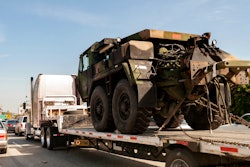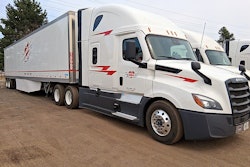Federal Motor Carrier Safety Administration issued regulatory guidance emphasizing that a fire or explosion in a commercial motor vehicle that results in a death, injury requiring transportation to a medical facility or the towing of the vehicle meets the definition of an accident even if there is no collision involved. The guidance appeared in the July 24 issue of the Federal Register.
Kentucky increased speed limits on most interstate highways and parkways to 70 mph from 65
mph. Notable exceptions are the congested loops around Louisville and Covington, and parkways in the mountain regions in the east.
Security Council of American Trucking Associations honored Curtis Shewchuk, chief security
officer for Ann Arbor, Mich.-based Con-way Freight, with the 2007 Leadership Award, recognizing his contributions to the council’s development.
Arkansas Trucking Association recognized Dennis Hilton of Mabelvale, Ark.-based CalArk International as Safety Executive of the Year for 2006.
New Jersey Motor Truck Association honored James Daulerio, manager of safety, compliance and training for Delanco, N.J.-based Jevic Transportation, with its 2007 Safety Director of the Year award.
Acuity Insurance and A.N. Ansay & Associates presented Bensenville, Ill.-based Central States Trucking with its 2006 Fleet Safety Award.
Fatalities from accidents involving large trucks totaled 4,995 in 2006, a decline of 245 or 4.7 percent from 2005, the U.S. Department of Transportation announced in late July. The number of truck occupants who died in those accidents remained basically unchanged, from 804 fatalities in 2005 to 805 in 2006. Injuries among occupants of large trucks fell 15 percent, while injuries among occupants of passenger vehicles in all kinds of accidents dropped 4.7 percent.
Overall highway deaths were down, producing the lowest highway fatality rate ever recorded – 1.42 per 100 million vehicle miles traveled – and the largest drop in total deaths in 15 years, DOT said. In 2006, 42,642 people died in traffic crashes, a drop of 868 deaths compared to 2005. And fatalities among occupants of passenger vehicles continued a steady decline to 30,521 – the lowest annual total since 1993, Peters said. Injuries also were down in 2006, with passenger car injuries declining by 6.2 percent.
Peters cautioned that troubling trends continue in motorcycle and alcohol-related crashes; alcohol-related fatalities rose slightly in 2006 over the previous year, while motorcycle deaths rose by 5.1 percent. This is the ninth year in a row the National Highway Traffic Safety Administration has seen an increase in motorcycle deaths. “Proper training, clothing, gear and, above all, helmet use are essential to reversing this deadly trend,” said Transportation Secretary Mary Peters, who herself is an avid motorcyclist.
Drunk driving enforcement will continue to be a top priority for the department, said NHTSA Administrator Nicole Nason, noting no improvement in last year’s alcohol-related fatality numbers. In 2006, 15,121 fatalities involved a driver or motorcycle operator, pedestrian or cyclist who had a .08 or above BAC (blood alcohol concentration) compared to 15,102 in 2005, she said.
NHTSA collects crash statistics annually from the 50 states, the District of Columbia and Puerto Rico to produce reports on fatalities and injuries. The report can be seen at www.nrd.nhtsa.dot.gov/Pubs/810791.PDF.
DOT to study agricultural cargo securement
The U.S. Department of Transportation recently announced that it will fund a $250,000 study of the strength of cargo securement methods currently being used for several agricultural commodities hauled in tubs and bins, such as fruits and vegetables. The work will be conducted by a government research organization, the Volpe National Transportation Systems Center in Cambridge, Mass.
“This is welcome news for the fruit and vegetable industry in states such as California, because new cargo securement regulations are threatening to impose time-consuming additional requirements on the transportation system for such crops,” says Russell Laid, executive director of the Agricultural and Food Transporters Conference of the American Trucking Associations.
Preventable or not: Doe turns a blind eye
The sun was shining brightly on the Food Monster market in Pleasant Plains, Ark., as trucker John Doe slowly drove his tractor-trailer into the congested parking lot. After pulling into an adjacent blind alley to off-load some pallets, Doe cautiously backed his 48-foot reefer toward the parking lot. He was assisted in this maneuver by sharp-eyed senior bagger Matthew D. Monroe IV, who subsequently re-entered the Food Monster.
After reaching for some Spicy Ranch Doritos to munch on, Doe flipped on his Larry the Cable Guy CD and proceeded to execute a fairly sharp right turn, in preparation for departing the lot. Doe moved at a snail’s pace, constantly checking his mirrors for any possible clearance problems, as his truck’s speakers repeatedly boomed “GIT ‘ER DUN!”
At that moment, Woody Wilson whizzed around the corner of the store in his purple 2007 Dodge Charger – tricked out to the max, of course – and parked illegally in the fire zone, which as fate would have it, was in Doe’s blind spot and fell just within the arc tracked by Doe’s departing trailer










